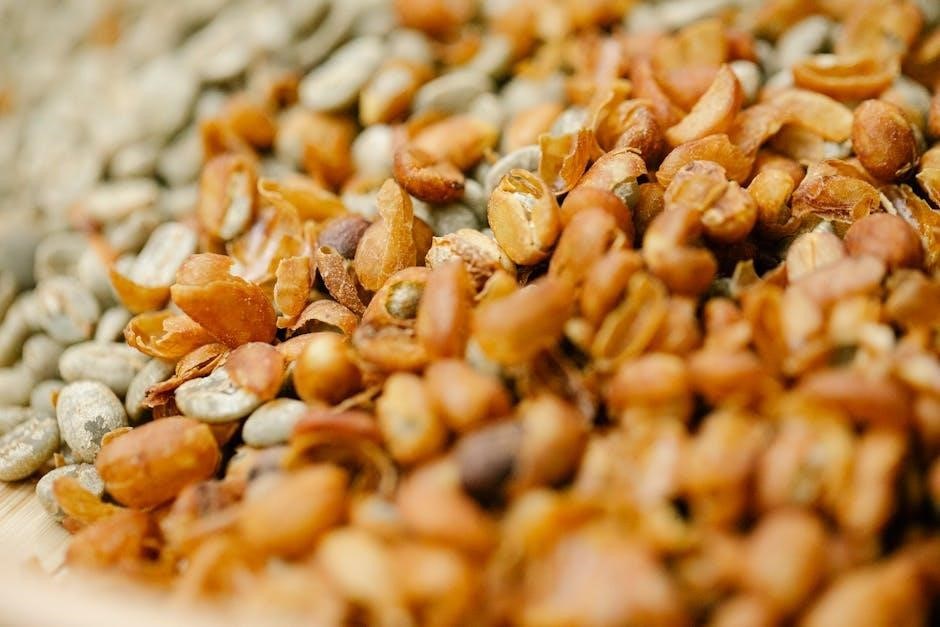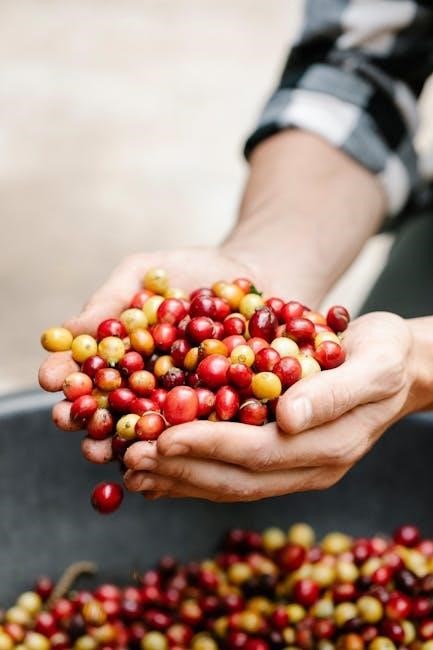Coffee beans are the heart of every great brew, offering a journey from farm to cup. Their unique flavors, shaped by terroir and processing, make each sip extraordinary.
Overview of Coffee Beans and Their Importance
Coffee beans are the foundation of the coffee industry, representing a journey from farm to cup. They are the seeds of a fruit, often misunderstood, and their quality and flavor are shaped by terroir, processing, and roast levels. With two main types—Arabica and Robusta—each offers distinct characteristics, influencing the final brew. Understanding coffee beans is crucial for coffee lovers, as their origin, processing methods, and roast levels determine the flavor profile. From light, acidic notes to deep, bold tones, coffee beans provide endless variety, making them a cornerstone of culinary and cultural experiences worldwide. Their importance lies in their ability to connect people across regions and traditions.

Types of Coffee Beans
Coffee beans primarily come in two types: Arabica and Robusta. Arabica is known for its smooth, nuanced flavor, while Robusta offers boldness and higher caffeine content.
Arabica vs. Robusta: Understanding the Differences
Arabica and Robusta are the two primary coffee bean types. Arabica, grown at high altitudes, offers a smooth, nuanced flavor with hints of fruit and floral notes. Robusta, cultivated at lower altitudes, is known for its bold, harsh taste and higher caffeine content. Arabica beans are more sensitive to climate and soil, making them harder to grow, while Robusta is more resilient. Arabica is preferred for specialty coffee, while Robusta is often used in espresso blends for its crema-enhancing properties. Understanding these differences helps coffee lovers choose beans that suit their taste preferences and brewing methods.
Coffee Bean Processing Methods
Coffee bean processing methods, such as washed, natural, and honey, significantly impact flavor and quality. These techniques determine how beans develop their unique characteristics.
Washed, Natural, and Honey Processing Explained
Coffee processing methods like washed, natural, and honey significantly influence the final flavor profile. Washed processing involves removing the fruit’s skin and pulp before drying, resulting in a cleaner, brighter taste. Natural processing leaves the fruit intact, creating sweeter, fruitier notes. Honey processing is a hybrid method, where some pulp is removed, balancing acidity and body. Each technique requires precise control, impacting the beans’ quality and flavor complexity. Understanding these methods helps coffee enthusiasts appreciate the craftsmanship behind their brew, ensuring a more informed and enjoyable coffee experience.
Coffee Bean Regions and Flavor Profiles
Major coffee-producing regions like South America, East Africa, and Southeast Asia offer distinct flavor profiles shaped by local climates and soils, creating unique tasting experiences.
Major Coffee-Producing Regions and Their Unique Characteristics
Major coffee-producing regions, such as South America, East Africa, and Southeast Asia, are known for their distinct flavor profiles. South America, particularly Brazil and Colombia, offers balanced, nutty notes with hints of chocolate. East African countries like Ethiopia and Kenya are celebrated for their bright acidity and fruity, floral nuances. Southeast Asia, including Indonesia and Vietnam, often produces earthy, herbal flavors with a rich body. Each region’s climate, soil, and altitude contribute to these unique characteristics, making the world of coffee incredibly diverse and rich in flavor experiences for coffee enthusiasts to explore and enjoy.
The Role of Terroir in Coffee Beans
Terroir, encompassing climate, soil, and altitude, profoundly influences coffee beans’ flavor. These environmental factors shape the beans’ unique profile, creating distinct regional tastes and aromas.
How Climate, Soil, and Altitude Impact Flavor
Climate, soil, and altitude are critical factors influencing coffee beans’ flavor. Climate affects temperature and rainfall, which determine ripening speed and sugar development. Soil type, ranging from volcanic to clay, impacts nutrient availability, altering taste profiles. Altitude slows maturation, enhancing complexity and acidity. High-altitude beans often exhibit brighter notes, while lower altitudes produce sweeter, heavier profiles. These environmental elements interact to create unique regional flavors, making each coffee bean distinct and reflective of its origin. Understanding terroir helps coffee enthusiasts appreciate the diversity and richness behind every cup.
Coffee Bean Roast Levels
Coffee bean roast levels define flavor profiles, ranging from light roasts’ bright acidity to medium’s balance and dark roasts’ bold, rich notes, each enhancing the bean’s natural characteristics.
Light, Medium, and Dark Roasts: What You Need to Know
Coffee beans are roasted to enhance flavor, with light roasts offering bright acidity and fruity notes, medium roasts providing a balanced taste, and dark roasts delivering bold, rich flavors. Light roasts retain more of the bean’s natural characteristics, while dark roasts have a deeper, smokier profile due to longer roasting times. Medium roasts strike a balance, combining acidity with a hint of sweetness. The choice depends on personal preference, brewing method, and desired intensity. Understanding roast levels helps coffee lovers select beans that align with their taste buds, ensuring a satisfying and personalized coffee experience every time.
Buying and Storing Coffee Beans
When buying coffee beans, opt for freshly roasted, high-quality options and store them in airtight containers away from light and heat to preserve flavor and aroma.
Tips for Selecting and Preserving Fresh Coffee Beans
When selecting coffee beans, prioritize freshness by checking roast dates and opting for high-quality, aromatic beans. Store them in airtight containers in a cool, dark place to preserve flavor and prevent oxidation. Avoid exposing beans to moisture or heat, as this can degrade their quality. For optimal freshness, grind beans just before brewing. If freezing, use an airtight bag and scoop only what you need while frozen. Freshly roasted beans typically peak in flavor within two weeks, so plan your brewing accordingly. Proper storage and handling ensure your coffee remains vibrant and full of flavor for a longer period.

Brewing with Coffee Beans
Brewing with coffee beans involves grinding them fresh and using methods like pour-over, French press, or drip brewing. Water quality and temperature are key for optimal flavor extraction.
Basic and Advanced Brewing Techniques
Mastering brewing techniques enhances coffee enjoyment. Basic methods include drip brewing, French press, and pour-over, requiring freshly ground beans and filtered water. Advanced techniques involve manual tools like Aeropress or siphon, offering precise control over extraction. Key factors like grind size, water temperature (ideally 195-205°F), and steeping time significantly impact flavor. For espresso, a fine grind and high-pressure brewing yield rich shots. Experimenting with ratios of coffee to water (1:15-1:17 for drip) ensures balanced brews. Proper equipment maintenance and water quality further elevate the brewing experience, making every cup a delightful expression of the coffee bean’s potential.

Coffee Bean-Related Health Benefits
Coffee beans offer numerous health benefits, including antioxidants that support cardiovascular health and brain function, enhancing alertness and overall well-being when consumed in moderation.
Exploring the Health Advantages of Coffee Consumption
Coffee consumption offers several health benefits, including high antioxidant content that supports cardiovascular health and brain function. Studies suggest moderate coffee drinking may improve cognitive function, reduce inflammation, and lower risks of chronic diseases like type 2 diabetes and Parkinson’s. Caffeine boosts alertness and physical performance, making it popular among athletes and individuals seeking mental clarity. Additionally, coffee contains essential nutrients like potassium and magnesium, which contribute to overall well-being. However, individual tolerance to caffeine varies, so moderation is key to maximizing health benefits while minimizing potential side effects like sleep disruption or increased heart rate.

Sustainability in Coffee Bean Production
Sustainability in coffee production focuses on eco-friendly farming practices, reducing environmental impact, and promoting ethical labor conditions, ensuring a greener future for coffee cultivation and trade.
Ethical Practices and Environmental Impact
Ethical practices in coffee production ensure fair labor conditions, equitable wages, and sustainable farming methods. Environmental impact is minimized through shade-grown coffee, organic farming, and water conservation. Certifications like Fair Trade and Rainforest Alliance promote eco-friendly practices, reducing deforestation and biodiversity loss. Sustainable agriculture helps mitigate climate change by reducing carbon footprints and promoting soil health. Consumers play a vital role by supporting brands committed to ethical and eco-conscious practices, fostering a more responsible coffee industry that benefits both farmers and the planet. By choosing sustainably sourced beans, coffee lovers contribute to a greener, fairer future for coffee production.
Mastering coffee beans involves exploring flavors, brewing techniques, and sustainability. Embrace the journey from farm to cup, savoring diversity and supporting ethical practices for a richer coffee experience.
Final Thoughts on Mastering Coffee Beans
Mastering coffee beans is a journey of discovery, from understanding their origins to refining your brewing techniques. Exploring diverse flavors, roast levels, and brewing methods ensures a personalized coffee experience. Proper storage and freshness are key to preserving quality. Sustainability and ethical sourcing are vital considerations for a responsible coffee culture. Embrace experimentation and learn to identify what resonates with your palate. With each sip, you connect with the craftsmanship and dedication of farmers worldwide. Whether you’re a casual drinker or a connoisseur, coffee beans offer endless possibilities for enjoyment and appreciation.
